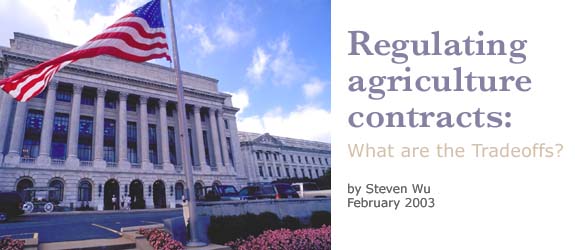|
The increasing use of marketing and production contracts in agriculture has raised concerns about their fairness for farmers and the need for possible contract regulation. Policy debates focus on "The Great Disparity in Bargaining Power and Marketing Information Between Contractor Companies [e.g., processors or integrators] and Individual Producers" and "Large Companies Often Offer Contracts to Producers on a Take It or Leave It Basis" (Iowa Attorney General Tom Miller, as quoted by Boehlje et al., 2001).
Federal and state policy makers have responded with proposed legislation to regulate agricultural contracts, although little is known about the intended and unintended effects of such regulations. Instead, public discussions often are emotionally charged with doomsday prophecies about family farms and the advent of corporate agriculture. Although intentions may be noble, socially responsible decision-making requires a dispassionate assessment of proposed policies and their potential costs and benefits. Especially important is the distinction between regulations that constrain versus facilitate private exchange by appropriately defining property rights and reducing transaction costs.
The Benefits and Costs of Contracting
In the current climate of industrialized agriculture, many puzzles exist for lawmakers and regulators. On the one hand, the greater coordination of the food system through contracts and integration has efficiency, equitability, and power effects. Contract production has improved the efficiency of the US agricultural system, allowed a clearer transmission of consumer preferences, and spawned new value-added products for consumers. Contract coordination from the farm through the retailer to the consumer is intended to ensure that quality and other product specifications are met. Quality incentives for various players along the vertical chain often are needed, and technology transfer (e.g., specialized inputs, buildings) by processors to use by growers may occur.
On the other hand, the increased concentration of large processors is eroding the economic power of small growers, raising questions about the equitability of contract arrangements, and expanding the potential for fraud and other dishonest behavior. Among farmers' complaints about processors are the discretionary termination of contracts, retaliation against growers who seek group action, unanticipated investment requirements, manipulation of quality-based incentive payments, and unfairness of tournament contracts in which one grower's compensation depends on his or her performance relative to that of other growers.
Policy Responses
In response to grower complaints, policy makers have proposed new legislation to protect growers. Senator Tom Harkin (Iowa) introduced the Agricultural Producer Protection Act (S-2343) to the 106th Congress in 2000, but the bill died. It was subsequently repackaged by Tom Daschle (South Dakota) in the 107th Congress and called the Securing the Future for Independent Agriculture Act of 2001 (S-20). Many states have also proposed new regulations. An example is the Producer Protection Act proposed by Iowa Attorney General Tom Miller and 16 other state attorney generals.
Rather than summarize each individual federal or state legislation, it is more useful to list briefly the most commonly proposed regulations, including:
- Implied promise of good faith regulations refer to honesty and observance of "reasonable commercial standards" of fair dealing with respect to performance and enforcement of contracts.
- Contracts should be in plain language and include a clear disclosure of risks to producers.
- Confidentiality clauses are prohibited. This would allow growers to consult attorneys and other advisors and make contracts more transparent.
- Termination laws would enable producers to recapture costs of capital investment if there were no breach of contract.
- Other regulations would ban unfair trade practices, such as retaliatory action against producers that attempt to organize and enhance their own bargaining power; ban relative performance contracts, such as tournaments; ban binding arbitration, so as to grant growers greater access to courts; or ban captive supplies or packer ownership of livestock 14 days or more prior to slaughter.
To determine whether some or all of the above should be made law, it is important for lawmakers to understand some of the economic tradeoffs that may exist under alternative policy scenarios. Some examples are:
- If processors are allowed discretionary power to change the terms of the relationship after the fact, is this used to ensure flexibility in maintaining the best production practices, or is this a way for processors to extract profits from growers?
- Are certain types of contracts (such as tournaments and other contingent contracts) used to provide stronger incentives, or are they used to shift risk to the growers?
- If a law banning discretionary termination of growers is implemented, does this lead to reduced incentives, or are there a sufficient number of substitute "policing instruments" available to processors to ensure good performance?
Before attempting to make initial economic assessments of proposed legislation, it is useful to describe briefly some general principles of regulation from an economics perspective.
Economics Perspective
The extent and form of regulation can have significantly different effects. If regulations ban or interfere with marketing and production contracts, social welfare could decrease, because the trading options of private parties are constrained. In contrast, regulations that protect property, enforce agreements, and safeguard the rights of individuals to fair treatment in business transactions conserve the time that market participants spend worrying about their investment and allow greater concentration on efficient production. The latter type of regulations can have important positive effects on incentives for investment and enhance trading opportunities between private parties.
Unfortunately, many policy analysts and activists fail to appreciate the difference between government constraints on private activities and government facilitation of individual rights and exchange among parties. When governments constrain market mechanisms too much, oversupply, food shortages, or other gross inefficiencies can occur. Similarly, when government enforcement is too hands-off, fraud and other opportunistic behavior may accelerate, as in the Enron and WorldCom debacles.
A study by Glaeser, Johnson, and Schleifer (2001) suggested that the adoption of legal rules that are highly protective of investors in Poland "stimulated the rapid development of securities markets" and noted that "the expropriation of investors has been relatively modest." Although this study was not specifically related to agriculture, it illustrated that the presence of institutions or legal rules to enforce trade agreements or contracts can facilitate private transactions and reduce the incidence of cheating.
The key point of this section is that although government interference in private mechanisms for exchange (e.g., contracts) is generally undesirable from an economics perspective, government involvement in defining rights and enforcing agreements is often necessary to ensure equitable exchanges. This framework can be carried forward to formulate some initial hypotheses about the possible outcomes of some of the current policy proposals.
How Might Some Currently Proposed Regulations Fare?
Without more extensive economic analysis, it is difficult to conclude whether policy proposals are "good" or "bad" for the rural economy. However, by using simple economic logic, we can formulate some initial hypotheses about a few of the current policy proposals.
An implied promise of good faith and ban on arbitration clauses: This legal rule makes sense both ethically and economically. A fundamental aspect of economic theory is that a decision maker will not pursue an activity beyond the point where its expected costs will exceed its expected benefits. Allowing contracting parties access to the courts so that they can sue for good faith damages raises the expected cost of dishonest behavior. Even the most dishonest participant can understand that it is worthwhile to be honest if dishonesty costs more than honesty. Furthermore, if each participant knows that her rights to investment returns will be protected by the courts, she is more likely to invest in the relationship. However, before declaring this regulation a winner, it is important to understand that resources will be wasted in nonproductive activities such as litigation and rent seeking. Policy makers should weigh this tradeoff before passing such regulation.
Confidentiality clauses prohibited: Economic theory suggests that reasonable bargaining solutions are easier to attain if the bargaining parties' fallback positions (their "walk away" price) or other relevant information are known to each party. Farrell (1987, p.115) stated that "when people don't know one another's tastes or opportunities, then experience, theory, and experimental evidence all confirm that negotiations can be protracted, costly, and unsuccessful." Thus, a first step in facilitating efficient bargaining is to ensure that all relevant information in the contract is clear to all parties; if there is confusion, producers should have the right to consult with advisors. Furthermore, without confidentiality, contract terms can be used to identify the fallback positions of contracting parties. Efficient bargaining outcomes are facilitated, and resource allocation can improve. In contrast, allowing confidentiality clauses for intellectual property rights and proprietary information helps protect investments in research and development.
Recapture of capital investments: If the processor unduly terminates the contract, the producer can recover at least part of the capital investment required by the contract. This regulation could have ambiguous economic effects. On the one hand, by avoiding undue termination, the grower can confidently invest more in the relationship. The effect is similar to warranties, which protect consumers from sinking their hard-earned money into defective products. Moreover, it shifts capital investment risk to processors, who may bear such risks more effectively. On the other hand, contractees may work harder when they have something at stake and when they fear termination for underperformance. The possibility of losing one's investment resembles a performance bond to ensure optimal performance. Without economic analysis, the net effect of this regulation is unclear.
Banning unfair trade practices: Preventing retaliatory action against producers who want to join producer associations facilitates the emergence of producer bargaining associations. These associations can offset the market power of processors in input markets. The presence of monopsony power (single buyer with market power) can drive input prices below competitive levels. By organizing, producers can offset some of the monopsony power of processors and negotiate more equitable contract payments.
Banning captive supplies, corporate ownership, or tournament: Bans that interfere with private exchange arrangements would conflict with the basic principles of a free market. The government seldom bans contracts and comparative performance appraisals in other industries. In competitive markets, comparative performance evaluation is often used to determine pay or promotions. Moreover, tournaments can actually shield growers from common risks (Tsoulouhas & Vukina, 2001). For example, suppose bad weather affects an entire region and thus all growers within a tournament. These growers would avoid the negative financial effects of the bad weather, because only their relative performance matters in payment calculations. On the other hand, if the same growers were compensated using a fixed performance contract, each grower would feel the full effects of the weather shock, because now only absolute performance matters. If processors manipulate tournament outcomes through the unfair distribution of inputs and/or the falsification of grower rankings, the solution is not to ban tournaments but to create third-party verification and to increase penalties for fraud. This would protect growers' rights to fair treatment but at the same time preserve processors' rights to use exchange arrangements that ensure quality and competition among their suppliers. In sum, regulations that ban contracts, private ownership, and comparative performance evaluations could stifle growth in the same way that large subsidies, export quotas and tariffs, and other forms of government control of market exchange have hampered private enterprise, consumer satisfaction, and open competition in the past.
Final Thoughts
Simple economic logic illustrates that regulations can raise difficult issues and may not necessarily achieve their intended effects. Policy analysts must consider the difference between regulations that constrain the ability of private parties to conduct efficient transactions, and regulations that facilitate private exchange by appropriately defining property rights and reducing transaction costs. Additionaly, most political debates concerning new contract legislation focus on farmers and processors but not consumers. However, contract regulations are likely to impact the value chain from the farm gate to the consumer through the range and prices of new foods products.
From an economics perspective, regulations are intended to correct market failures and/or reduce transaction costs of market participants. Policies that constrain the ability of private parties to conduct efficient transactions exacerbate market failures, while policies that enforce and define rights reduce market failures and transactions costs. A failure to assess the efficacy of a specific regulation in promoting private transactions may lead to unintended consequences and negative net benefits to society. Ultimately, a policy should be judged by whether it induces private and social benefits that will outweigh private and social costs, and on whether the distribution of benefits is consistent with the values of our society. To expedite these comparisons, disaggregate data collected by government agencies must be made readily available to researchers, and substantial financial support may be required to get projects completed.
With increased global competition, food processors will continue to vertically coordinate their production chains to meet consumer needs. This will raise a host of new issues for the farming sector and increase demand for new and unprecedented regulations. How these regulations will benefit society will hinge crucially on whether their creation and passage are based on special interests and politics, or on careful and measured economic analysis of their costs and benefits to all segments of society.
For More Information
Boehlje, M., Schrader, L., Hurt, C., Foster, K., and Pritchett, J. (2001). The producer protection act—will it protect producers? Purdue Agricultural Economics Report. West Lafayette, IN: Purdue University.
Farrell, J. (1987). Information and the Coase theorem. The Journal of Economic Perspectives,1, 113-129.
Glaeser, E., Johnson, S., and Shleifer, A. (2001). Coase versus the Coasians. The Quarterly Journal of Economics, 116, 853-899.
Tsoulouhas, T. and Vukina, T. (2001). Regulating broiler contracts. American Journal of Agricultural Economics, 83, 1062-1073.
|
|




